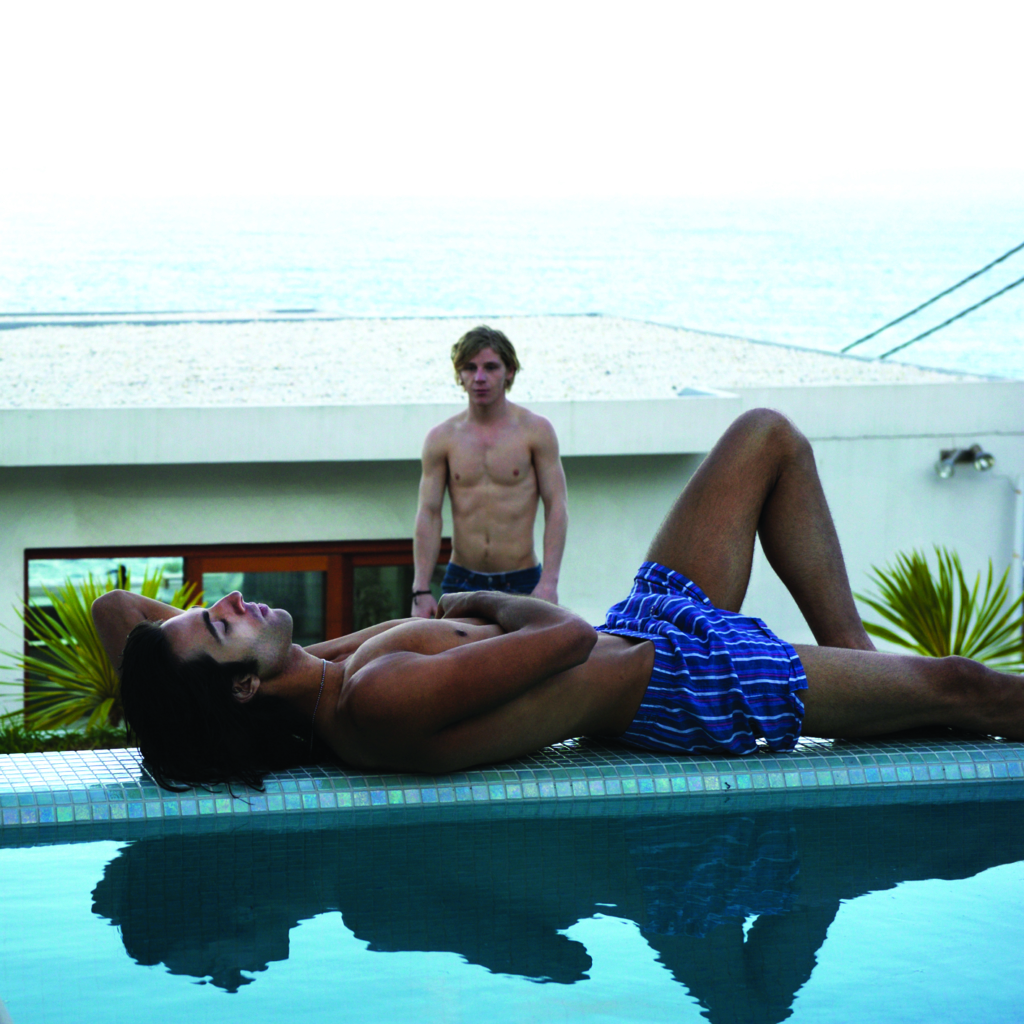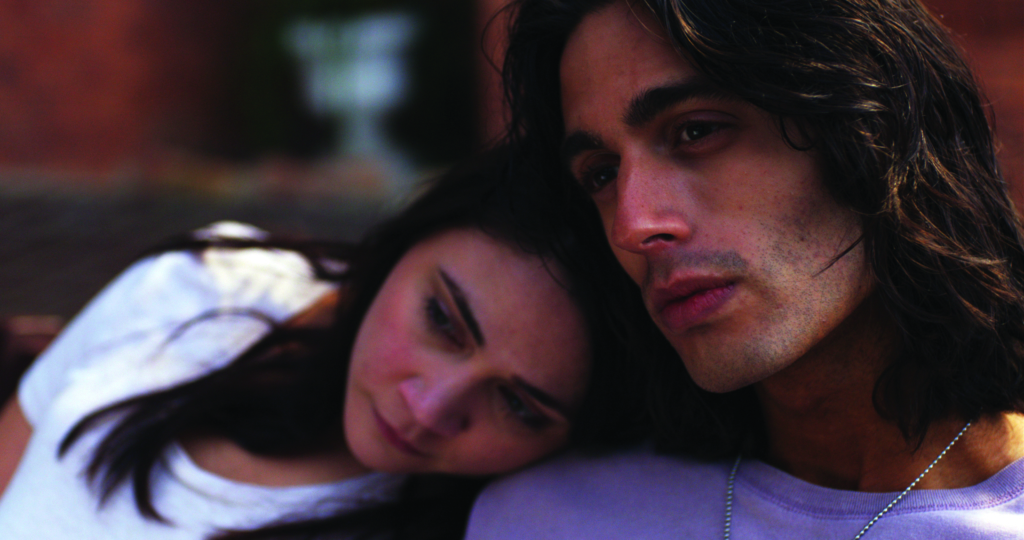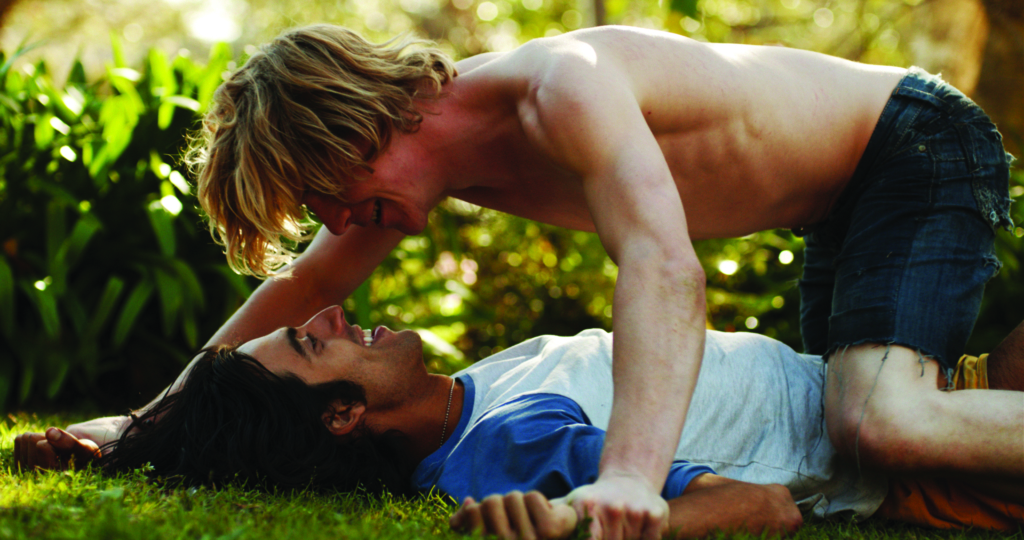In the opening scene of Teenage Kicks (Craig Boreham, 2016), two young men sit on a bed taking hits from a bong made out of an empty flavoured-milk container. The eyes of Dan O’Connel (Daniel Webber) are fixed on the porn video playing on the television, but the eyes of Miklós ‘Mik’ Varga (Miles Szanto) are flitting between the girl-on-girl action on the screen and the body of his best friend. Obviously the less shy of the two, Dan – with his school shirt unbuttoned – extends his hand into his pants, which only makes Mik’s voyeurism more daring; it’s not long before Mik takes Dan’s lead and gropes himself as well. Mik’s face, covered in shaggy surfer’s hair, is barely able to contain his teenage lust – but, as his eyes dance between the telly and his object of lust’s body, in walks Dan’s father (Ian Roberts), who breaks up the party. Boner-killer.
If the movies are to be believed, this intimate scene and others just like it are something of a regular occurrence in the world of the adolescent gay male. As a gay man myself, maybe I was just never attracted enough to any of my friends, and not brazen enough to attempt anything even if I was. But the closest I ever got to anything this erotically charged at this age was sneaking off from a party with a cute boy from another school who was clearly questioning his sexuality; ultimately, the encounter went nowhere. But then again, I also didn’t look twenty-four and have a perfect tan.

Nevertheless, these are the sorts of moments in a young gay kid’s life that filmmakers have suggested – time and time again – are a rite of passage, regularly appearing in queer coming-of-age films. In the last five years alone, we’ve seen films from all over the world cover similar terrain – North Sea Texas (Bavo Defurne, 2011) from Belgium, Boys (Mischa Kamp, 2014) from the Netherlands, Henry Gamble’s Birthday Party (Stephen Cone, 2015) from the US and Seashore (Filipe Matzembacher & Marcio Reolon, 2015) from Brazil, to name just a few. These titles dramatise the sexual awakening of young men as they stare winsomely off into the distance, away from the dissatisfaction plaguing their lives and into the eyes of somebody who may or may not share their feelings.
Coming out still carries a lot of emotional baggage for non-heterosexual and trans young people, and … it remains a difficult part of life for many. For this reason, young queer Australian viewers need films that reflect their life experiences.
While it may be nice to fantasise about this motif, it makes critiquing the many films it is present in occasionally rather frustrating: films targeting younger LGBTQIA audiences are rare enough as it is in Australia without having to sit through tired narrative beats. Coming out still carries a lot of emotional baggage for non-heterosexual and trans young people, and – in spite of the world moving dramatically forward on LGBTQIA issues – it remains a difficult part of life for many. For this reason, young queer Australian viewers need films that reflect their life experiences. But what does it mean to tell a queer Australian coming-of-age story? What can a filmmaker do to make their tale of sexual discovery uniquely Australian?
Cultural specificity is a valuable asset that can set a work apart from what is literally a global queer filmmaking niche that has, arguably, reached saturation point. There’s no mistaking that local examples like Tan Lines (Ed Aldridge, 2007) and Monster Pies (Lee Galea, 2013, blandly retitled Beautiful Love in some international markets) achieved whatever meagre success they did – the latter won the Audience Choice Award for Best Feature at the 2007 Melbourne Queer Film Festival, while the former was, purely anecdotally, a staple in the specialty queer shelves of local DVD retailers – because they were distinctly Australian stories that were different in tone and voice from other examples of the subgenre from across the globe. At the same time, though, young viewers deserve stories that are – quite frankly – better than these still-flawed examples.

The basic framework of Teenage Kicks certainly has a lot of potential: Mik’s sexual curiosity is cresting, but takes a damaging turn for the worst after he is caught watching his brother, Tomi (Nadim Kobeissi), masturbate. Tomi is furious at the incestuous intrusion and flees, only to be involved and subsequently die in a car accident. As the underachiever of the family, Mik finds himself on the receiving end of his family’s anger, even though they are unaware of the sexual specifics that led to it. Soon, after initially offering Mik some fleeting hope that his lust may be reciprocated, Dan grows fond of Phaedra (Charlotte Best), throwing Mik’s future plans for the pair to escape their small-town hellhole into turmoil. Meanwhile, Mik builds a friendship with Annuska (Shari Sebbens), his late brother’s heavily pregnant girlfriend, who sees in him a kindness and sensitivity that shows how alike Mik and Tomi truly were.
As Teenage Kicks is set in Sydney, one might think that the issues of ethnicity and Otherness – the Vargas are a ‘migrant family’[1]Azure Productions, Teenage Kicks press kit, 2016, p. 4. – and how these interact with class and affluence, would figure prominently. Yet these are most accurately described as mere dramatic decorations rather than subjects that the film deeply explores. Undeniably, it’s hard for a film to offer anything as pointed in its confluence of homosexuality and race as Head On (Ana Kokkinos, 1998), but, nearly twenty years on, the time is ripe for a fresh take through twenty-first century eyes. Likewise, religion is hinted at throughout, particularly in the omnipresent cross that Mik wears around his neck, but the film never challenges his reverence to it as somebody who is questioning his sexuality. Furthermore, an early sequence at Tomi’s funeral observes the Varga family’s strong faith, but not once is Tomi’s having a child out of wedlock or the parents’ own curious love triangle of infidelities ever examined up close in relation to it. The lens bypasses the issue so much, it’s a wonder that it’s there in the first place.
It would have been interesting to see Boreham – who also wrote the screenplay – explore the impact of both faith and ethnicity on sexuality, rather than turning to the clichés of gay indie cinema. These are the sorts of themes that allow a film to stand out from the crowd, offering something insightful for audiences who may be struggling with these issues and/or are burnt out by the sorts of plot developments to which Teenage Kicks resorts. Indeed, Boreham has created yet another film with a gay lead getting involved with drugs. In this case, Mik falls in with a pair of charismatic users in Kings Cross who sell their bodies online for money, while an angelic heroin addict watches in the corner just waiting to pivot our hero back to the right path. Teenage Kicks could have been set in the 1980s, considering how little it has to say about the specifics of being a gay teen in the present day.

Boreham is a first-time feature director who has made many short films, including Drowning (2009) – whose protagonist is also played by Szanto – which Teenage Kicks expands to feature length. In spite of my criticisms of the film, it’s a testament to Boreham’s skills that he has made the film look as good as it does on such a small budget. Much praise must go to cinematographer Bonnie Elliott, who created the look of the film using predominantly natural light over a five-week shoot in the middle of winter (you wouldn’t know it was so cold!). After the film’s world premiere at the Sydney Film Festival in June, Boreham spoke of the ‘unconventional’ manner in which they shot the film – they opted not to use storyboards, shot lists or elaborate set-ups, a trick that allowed the actors to roam throughout the frame as though on a theatre stage. Elliott’s work, previously seen in These Final Hours (Zak Hilditch, 2013) and Spear (Stephen Page, 2015), is the stand-out element of the film. The visual aesthetic she devised for Teenage Kicks has an organic nature to it: sunny and elegant, with a slight hint of handheld that allows for a picturesque yet laid-back summery feel. It’s a style that acts as a relieving tonic from the occasionally grim material, and saves the film from simply falling back on the easy trope of gritty, overcast camera work that evokes gravitas – something that queer cinema all too often relies on.
Luckily, too, Teenage Kicks has Szanto – a captivating presence even as the film skids perilously close to the edge of good taste – at its core. The camera gazes upon his striking face (not to mention the rest of his body, of which we see all) lovingly. It’s not a brave performance in the way that actors portraying gay characters have been described, but it’s clear that having worked with Boreham before has allowed the young actor to deliver in a role that requires confidence in portraying internal angst.
Not all new entries into the local queer-film universe can be as polished and accomplished as Holding the Man (Neil Armfield, 2015), as playful with genre as Cut Snake (Tony Ayres, 2014) or as innovative and full of attitude as 52 Tuesdays (Sophie Hyde, 2013). However, when we consider the increasing visibility of not just homosexuality but also bisexuality, sexual fluidity, pansexuality and other orientations among the rapidly expanding lexicon of modern sexuality, is a story about a teenage boy infatuated with his best friend enough? I don’t think it is. Boreham has spoken of how he sees Mik as ‘the Q in LGBTIQ’, occupying
that place of exploration and trying to make sense of how you’re feeling and being driven instinctively and intuitively, rather than politically. There are a lot of young people who are definitely embracing identity politics vehemently as well, but I do think the rigidity of those labels aren’t as fixed as they were before.[2]Craig Boreham, quoted in Stephen A Russell, ‘Teenage Kicks Steams up Sydney Film Festival’, SBS Sexuality, 30 May 2016, <http://www.sbs.com.au/topics/sexuality/article/2016/05/30/teenage-kicks-steams-sydney-film-festival>, accessed 1 August 2016.

But these words fall apart when measured against the actual film. Mik’s two instances of heterosexual sex are born, more than anything else, out of fear and from the heteronormative expectation to step up and ‘be a man’ for a family that needs a patriarch in a time of crisis. If Boreham intended Mik to be ‘queer or questioning’, as he suggests, then he didn’t take this element of the character’s identity far enough.
When we know for a fact that the mainstream viewership of queer film has rapidly disintegrated in the last decade,[3]See Benjamin Riley, ‘Local Audiences Aren’t Supporting Queer Aussie Films: Melbourne Queer Film Festival Director’, Star Observer, 19 February 2015, <http://www.starobserver.com.au/news/national-news/victoria-news/local-audiences-arent-supporting-queer-aussie-films-mqff-director/132770>, accessed 1 August 2016. and with the awareness that similar titles are overcrowding local and queer film festivals and streaming services, it simply isn’t wise to give the potential audience something that wouldn’t have been out of place in earlier decades. Ultimately, Teenage Kicks is a disappointment for viewers for whom modern explorations of sex, sexuality and love are vital, especially when crafted around issues of multiculturalism and class, but who likely won’t get much out of this particular story.
http://www.teenagekicksthemovie.com
Endnotes
| 1 | Azure Productions, Teenage Kicks press kit, 2016, p. 4. |
|---|---|
| 2 | Craig Boreham, quoted in Stephen A Russell, ‘Teenage Kicks Steams up Sydney Film Festival’, SBS Sexuality, 30 May 2016, <http://www.sbs.com.au/topics/sexuality/article/2016/05/30/teenage-kicks-steams-sydney-film-festival>, accessed 1 August 2016. |
| 3 | See Benjamin Riley, ‘Local Audiences Aren’t Supporting Queer Aussie Films: Melbourne Queer Film Festival Director’, Star Observer, 19 February 2015, <http://www.starobserver.com.au/news/national-news/victoria-news/local-audiences-arent-supporting-queer-aussie-films-mqff-director/132770>, accessed 1 August 2016. |





